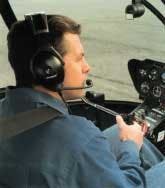Military pilots and crew block out the noise with Bose headsets
By John McHale
FRAMINGHAM, Mass. — Nearly everyone has heard about the Bose radio and compact-disc players. However, Bose engineers are also masters at filtering out unwanted noise to make for clearer communications in noisy, battlefield environments with their Combat Vehicle Crewman headset and their aviation headsets.
Soldiers say they love these headsets because not only does Bose's noise-reduction technology enable them to do their jobs in mission-critical situations, but the headset also is light and comfortable to wear, says Chris Miller, senior production manager of communications products for the Bose Noise Reduction Technology Group in Framingham, Mass.
Prior to the Bose device, headsets that canceled out unwanted noise were heavy and cumbersome, and lightweight headsets let in too much noise. "The Bose headsets lessen fatigue and improve mission effectiveness," Miller says.
The Combat Vehicle Crewman headset went into production for the U.S. Army in 1994. The contract was renewed for the Performance Improved Combat Vehicle Crewman headset that Army personnel now use on the M-1 Abrams main battle tanks and Bradley Fighting Vehicles, Miller says.
U.S. Air Force C-130 pilots and allied ground and air force troops are also outfitted with Bose active-noise-reduction headsets. Bose is supplying all crewmembers — not just pilots — on the U.S. Air Force Airborne Warning and Control System (AWACS) aircraft with the improved Aviation Headset X that weighs 12 ounces, Miller says.
Although Bose also produces commercial versions of their aviation headsets as well as the Quiet Comfort headset for home use, the military remains a significant part of their business, Miller says.
The core technology is the same, yet the military headsets are more rugged, Miller says. The Army versions are the most rugged to keep out dirt and dust and resist wear and tear, he continues. The Air Force versions are designed with electromagnetic interference shielding and prevent against ejection windblast and high G loads.
The concept behind noise-reduction technology began about 25 years ago on a commercial airline flight, when the company's founder, Dr. Amar Bose, had his first experience with the electronic headphones that were then being introduced for enhanced passenger entertainment, Miller says. Bose found that the fidelity benefits of the new phone made up for the increased cabin noise, so he decided to come up with headphones to reproduce speech with high fidelity while simultaneously reducing unwanted cabin noise.
The Bose noise-cancellation headsets have analog electronic components, Miller says. Each ear cup has a small microphone that listens to ambient sounds, and then filters out unwanted noise for listening to communications, silence, or music.
According to Miller, a portable control module and battery pack attaches to the headset by a cord. The Aviation X headset uses two AA batteries and can last 40 hours — sometimes longer, depending on noise levels in the aircraft.
The control module on the Aviation Headset X — Bose's latest noise-cancellation product — is 30 percent smaller than the previous version, and puts its dual thumbwheel volume controls within easy reach. The boom microphone enables smoother, more precise, and more reliable microphone placement on either ear cup to better meet pilots' preferences, company officials say.
Power management is through Bose's AdaptiSense headset technology, which regulates battery voltage to supply only the power that the headset needs. The system also detects when the pilot has stopped wearing the headset and automatically shuts off power to the active noise-reducing circuitry.
A new tri-color indicator with day/night brightness adjustment provides continuous, real-time battery status, so the pilot can determine when it is time to change batteries, company officials say. The Quiet Comfort uses one AAA battery and lasts approximately 40 hours, Miller adds. For more information, contact Bose online at www.bose.com.

